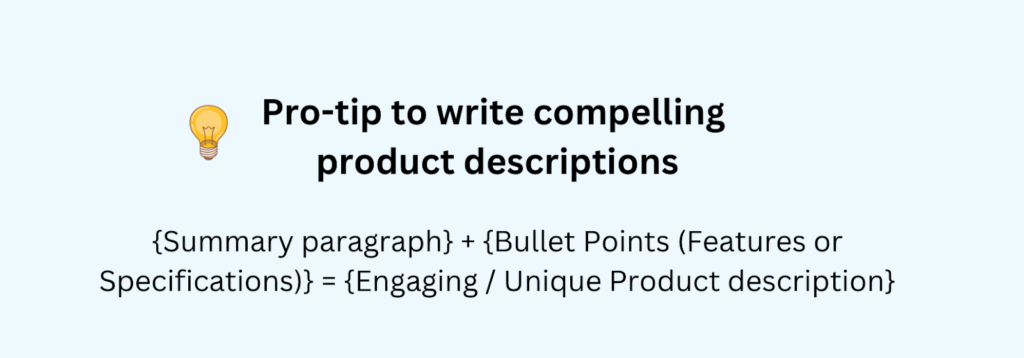What is eCommerce product catalog management?
eCommerce product catalog management refers to creating, updating, enriching, optimizing, and organizing product information. The product catalogs must be managed and organized in a structured fashion and must be comprehensive, error-free, and engaging so that online sellers can create a better customer experience.
Effective product catalog management is crucial for the success of an online store.
The importance of eCommerce product catalog management
✅A product catalog that is well-organized and managed enables ease of navigation, discoverability, and engagement for the customers. This enhances customer experience
✅Maintaining accurate and up-to-date product information reduces product returns and improves customer satisfaction
✅An optimized product catalog can improve search engine visibility and improve the chance of conversions
✅A well-managed product catalog can facilitate cross-selling and upselling by recommending related products, increasing the average order value
✅Managing catalogs for different regions or languages allows e-commerce businesses to expand into international markets
The challenges of product catalog management
✅Ensuring data accuracy
✅Maintaining product data consistency
✅Keeping product information up to date
✅Managing multiple variations of a product
✅Adapting catalogs for different regions and languages
✅Ensuring products are discoverable through search engines
✅Reducing manual catalog management tasks
Best practices of product catalog management
Let’s look at the five best practices of eCommerce product catalog management:
1. Make your catalogs comprehensive and engaging
Here are the key elements of your product catalog:
- Product title: The title is the first textual content that a potential buyer would read in a product catalog. You have to make it complete and engaging by including the product name, and brand, highlighting a key feature, and quantity
- Rich feature snippets and comprehensive descriptions: Explain what your product does, and why a customer should purchase it. Always put yourself in the perspective of the buyer and their address questions
Ask yourself these questions before you write descriptions.
- Who is the product for?
Think through the target audience, gender, demographics, age, etc.
- What constitutes basic details?
Attributes like dimensions, product features, and their functions.
- Why should a buyer choose you?
Highlight your USPs, features, and benefits.

Digital assets
Images fill in the gaps in the intangibility of the product. Hence, they have to be high in resolution and must cover all angles. You must also consider adding more resources like how-to videos, buying guides, brochures, and data sheets to elevate the customer experience.
Information on price, reviews, ratings
63% of consumers are more likely to purchase from a site if it has product ratings and reviews.
This means you cannot leave money on the table. As we are aware consumers tend to trust a product based on what other customers who have used the product think. You must always prompt your customer to leave a review or rating either on the product pages or as pop-ups post a sale.
2. Hit the refresh button when product data becomes stale
Bad data is information that is no longer accurate, useful, or meaningful. Bad data could be in any form; obsolete information, missing information, or misleading information.
This has a ripple effect and affects the end customer. Bad data spread happens because of overlooking the need and necessity to spend time and effort refreshing it. In an attempt to sell more and stay profitable, data relevancy takes a toll leaving a long-term impact on the primitive profitability motive.
Additions to product information to keep buyers informed.
Customers visiting your product page would like to dig deep into every detail of information and they are full of questions. Your product data cannot cover them all, it shouldn’t. But, your product data must be updated and always relevant.
The additions you make would certainly improve conversions. Sometimes it is not even about conversions. Keeping your customers aware of additional features or new versions saves them the time and hassle required for research. For instance, if you are a seller of Android phones, updating the latest version upgradability to a mobile helps buyers save time on extra research.
Let’s look at another use case where updating information improves customer experience. You cannot expect the entire target to be aware of your launches and upgrades. If they fail to learn your expansions through your marketing communications, product data is where you should have them covered.

Let’s say a makeup brand (Sephora) has introduced a new lipstick shade, this addition or enrichment should be a part of the product information to ensure your customers are on the same page of your launches and growth.
This holds good for obsolete information also. In the same example, for instance, if the beauty brand has stopped manufacturing a particular shade, then having it in the colors palette is stale data and enrichment is about removing wrong data too.
3. Write product catalog content that is engaging
Enriching is a holistic process. If your content is not originally written and in a tone that instantly connects with your customer, your product data won’t be helping you with conversions. You must avoid the reader’s autopilot, eliminate guesswork, and keep them engaged with your product copy. Here’s an interesting copy from a cookie dough brand that sells these edibles on subscription. They’ve gone the extra mile to make the copy click with the customer:

Quick product data copywriting tips:
- Revoke to emotional appeal and maintain the tone of the brand
- Perform proofreading and editing at various levels to avoid errors
- Address what’s in it for the user. Be relatable and talk about the challenges and hassles faced by the customer
- Paint a picture for the user and empathize with what section of the audience will be using your product
- Avoid empty phrases that do not convey anything. Eliminate blandness in your copy and make information insightful
- Use sensory words if the product kind is such that it requires appealing to the emotions and engaging the user
- You can always feature the creators of a new product or the story behind it to instigate belongingness
4. Make the purchase decision easier with digital assets
Digital assets make the purchase decision quick, give the look and feel of the product, and make the textual content interesting.
Images and videos
This is a handbag from Fossil.

The work on digital asset creation is quite commendable here, they have images of every compartment giving an idea of how much you can fit in them. Also, the product information is well thought out.
They also have videos guiding you through how it’d look when you hang the sling bag on your shoulder. This makes purchase decisions easy. Texts cannot cover everything you want to convey. Images/ videos are a great way to communicate and give out a clear picture.
Check out the page and the video here.
Videos need not necessarily be about the product. Apart from that you could also have additional ones that are insightful resources for your visitors that could be as a how-to video, or demonstration.
It could also be about other products under the same brand umbrella. Depending on which industry you belong to and what categories you sell, you must advise, be an influencer, and offer useful content to customers as customer experience is not just about moving towards conversions, but letting them hear the voice of the brand, the command, quality, and selfless love towards the clan that gives them business.
Here’s a quick checklist for optimizing images:
- Images should be high in resolution. The size of the main product image should be 600×600 pixels and go up to 2000 x 2000 pixels
- The secondary images must have the size of at least 450 x 450 pixels and up to 2000 x 2000 pixels
- The product image should cover up to 83% of the screen
- Zoom-in option and multi-dimensional views are a must-have
- The background of the image should be in white
- The image must be clear and not cropped
5. Automating product catalog management and reducing manual efforts
When you deal with hundreds of thousands of product catalogs, it’d become practically impossible to manage all the product information, both textual and digital content manually without the interference of automation.
You would encounter a variety of problems like:
- Spending hours on manually writing product catalogs
- Standardizing the catalogs to meet unique channel requirements
- Enriching the catalogs by filling the missing information and removing errors
- Writing catalogs in multiple languages
- Strategize pricing and stay competitive
- Remove data discrepancies
It’s always a best practice to overcome these challenges by managing product catalogs with the power of automation. A PIM can help you standardize, normalize, enrich, and syndicate product data effortlessly from a single platform.
Final thoughts
Your product information goes through a lot of battles before it faces the customer. The journey is tiring as there is a series of searches, ranking, filtering, and clicking. In spite of all this, conversions could be a major hurdle. It is not easy to make customers clingy to your brand or products. To make that spark happen, you have got to obsess over giving your customers the best shopping experience.
When it comes to a good shopping experience on the product information front, it depends on how easy you make buying decisions. Customers are on the lookout for an immersive and tailor-made experience that makes buying decisions hassle-free. This needs a lot of effort in fine-tuning your product information and we hope this guide has helped you understand the gaps in your data.
You can prepare to give customers a memorable shopping experience by giving your product data a makeover – a three-step process: add essential elements, enrich information, and give away rich resources.
FAQs
Product catalog management involves collecting detailed product information, standardizing data entry, optimizing product data, ensuring accuracy, and presenting products in an engaging way on your e-commerce website.
Catalog management is the process of systematically organizing, updating, and presenting a collection of products in an efficient manner. It encompasses tasks like data entry, data consistency, ensuring data accuracy, and optimization to enhance the overall customer experience and drive sales.
A product catalog provides customers with essential information about products, such as descriptions, prices, images, and specifications, facilitating informed purchasing decisions. It also enhances the visibility of products in search engines.
An example of a product catalog is an online retail store’s website, where you can find various categories of products, each with detailed information, images, and prices. For instance, a clothing e-commerce store may have a product catalog with categories like “Men’s Clothing,” “Women’s Clothing,” and individual product listings for shirts, pants, dresses, etc.


